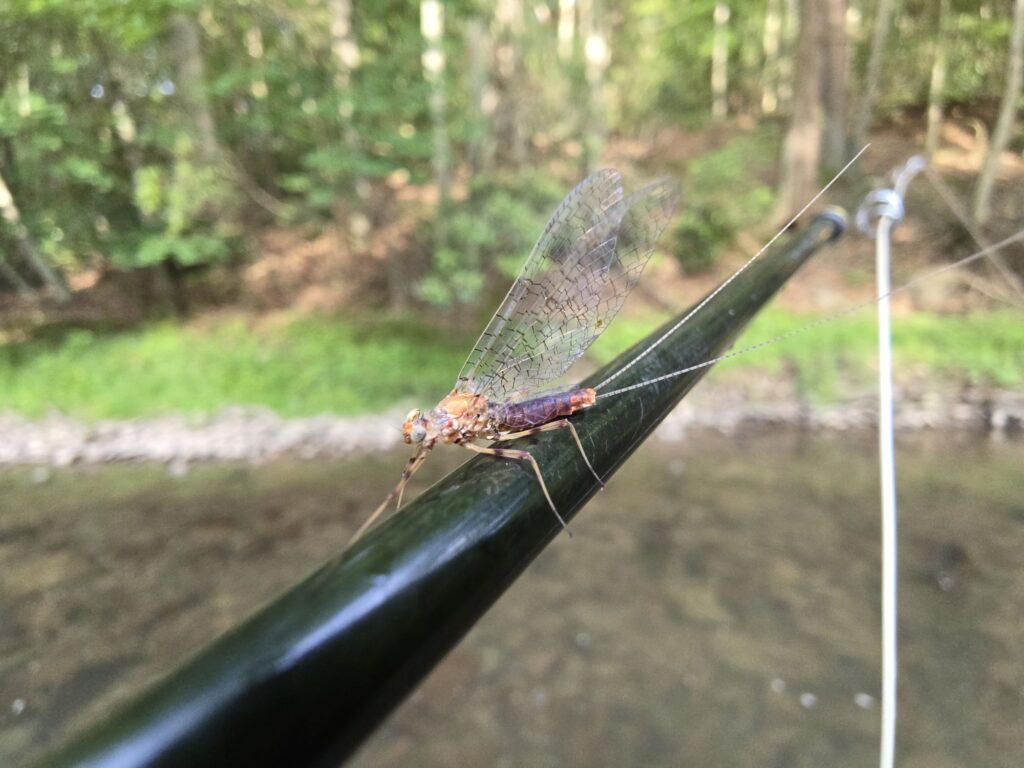
So I’m currently in Pennsylvania, USA (on a Fulbright Scholarship), surrounded by a heap of famous streams. Most of them start as limestone springs, and flow over shingle beds along the tight forested valleys of the Apalachian Mountains. Local streams include Spring Creek (next to our house, and the location of America’s first catch and release section of river), and Penns Creek in the next valley across.
Most of the streams are super-rich in mayfly hatches, including the giant green drake mayfly, sulphurs (yellow duns!), olives, and large slate drake (Isonychia) duns. On top of this there are three or four small caddis in either grey or black, giant stoneflies, and a heap of random terrestrials. A lot of the hatches are late evening hatches, so the pressure is on during the last hour and a half of light when the hatches start to peak.
I was fortunate to head out to Penns Creek earlier this week with a couple of retired locals, to target an evening hatch. The first thing that struck me was the different tactics used locally, compared to at home. While the locals set-up on a nice run and fished slowly and methodically across the fast runs, I fished upstream as I would at home. Within a few minutes I had finished two runs (managing a stockie rainbow along the way), while the other two were still in place fishing across the stream methodically.
Closer to evening we headed downstream to a section famed for dense hatches, where we parked our car in a forest next to three other angler vehicles, and walked about 200 metres to the water. The stretch of river was about 500m long before it opened into a patch of less fertile agricultural flats, and with three or four anglers already there, we headed to the gap at the downstream end of the forest run to stake a spot. Once we were set up, each angler on the 500m stretch had maybe one riffle and run to themselves at most. For the next two hours the hatches came and went, from large (size #10) Iso duns, to sporadic size #14 sulphurs (spectacular yellow duns), through to some form of tiny #22 dun which the fish went mad on (but were impossible to catch), and finally to the biggest half-hour hatch of all, the return of consistent sulphurs hatching off until dark.
I struggled for most of the hatch, catching a few little wild browns with my upstream presentations, but consistently putting fish down for minutes at a time. It began to remind me of the fish at Brumbys Creek 20 years ago, when the fish were more pressured by fly anglers than they are today (there use to be a lot more anglers). Back then the Brumbys fish would get put down by upstream casts, which they recognised as danger. Quite simply pressured fish become more sensitive to disturbance, but conversely they return to feeding pretty quickly. The same thing was happening to me on Penns Creek, and all of a sudden the local tactic of across-stream casting made sense. Cross-stream casting allows you to sight in on an individual fish, and repeatedly present accurate casts without getting the leader or line near the trout. In this manner it is a much better tactic for heavily-pressured or flighty fish, as you can keep your leader and line stealthily away from the trout. With heavy and bumpy streamflows over the rocky riverbed, and a forested backdrop, our casting positions were easily concealed from the nearby trout.
As soon as I switched to the across-stream method my luck changed. I was able to catch the rising fishing that I found, providing that I had a long drift on to the fish, giving the trout enough time to identify the Catskill’s style dry fly, and rise up through the fastwater and take it. It was a great reminder of the importance of tactics in fly fishing, and the value of across-stream presentations to extra-spooky fish.

Slate drake (Iso) dun, Penns Creek
